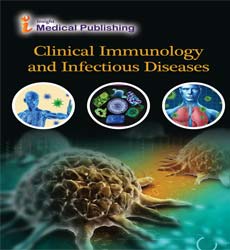Reach Us
 +447897072958
+447897072958
Advances in Immunotherapy for Infectious Diseases: From Bench to Bedside
Susanne Aladag*
Department of Pediatrics, Medical College of Georgia at Augusta University, Augusa, Georgia*Corresponding author:
Susanne Aladag, Department of Pediatrics, Medical College of Georgia at Augusta University, Augusta, Georgia, E-mail: susanne@aladag.geReceived date: January 01, 2025, Manuscript No. Ipciid-25-20577; Editor assigned date: January 03, 2025, PreQC No. Ipciid-25-20577 (PQ); Reviewed date: January 15, 2025, QC No. Ipciid-25-20577; Revised date: January 22, 2025, Manuscript No. Ipciid-25-20577 (R); Published date: January 28, 2025, DOI: 10.36648/.9.1.2
Citation: Aladag S (2025) Advances in Immunotherapy for Infectious Diseases: From Bench to Bedside. Clin Immunol Infect Dis Vol.9 No.1:2
Visit for more related articles at Clinical Immunology and Infectious Diseases
Introduction
Advances in immunotherapy for infectious diseases have moved rapidly from concept and preclinical promise to tangible clinical impact, expanding beyond passive immunity to encompass engineered antibodies, cellular therapies, host-directed immunomodulators, and platform vaccines that together offer new ways to prevent, treat, and even cure infections that were previously difficult to control; these innovations aim not only to neutralize pathogens directly but also to shape host responses to improve pathogen clearance, limit immunopathology, and reduce long-term sequelae [1].Description
Passive immunotherapy with monoclonal and broadly neutralizing antibodies has matured into a practical tool for both prophylaxis and therapyâ??examples include long-half-life monoclonals for pre-exposure prophylaxis and highly potent antibodies against malaria and respiratory virusesâ??offering immediate, targeted protection for high-risk populations and bridging gaps when vaccines are unavailable or ineffective [2]. Engineered cellular therapies and immune cell engagers are extending immunotherapyâ??s reach into infectious disease: CAR-T and CAR-NK platforms, as well as bispecific T-cell engagers, are being adapted to target virally infected cells and persistent reservoirs (e.g., EBV, HIV models) or to eliminate pathogenic immune subsets in dysregulated states, though their clinical use in infections remains early and requires careful management of toxicity and infection risk. Complementing pathogen-directed approaches, host-directed immunomodulationâ??including checkpoint blockade to reinvigorate exhausted T cells, cytokine modulation to blunt harmful inflammation and repurposed pathogen control or prevent immunopathology; these approaches demand precise timing and biomarker guidance Immunomodulatory drugsâ??offers strategies to enhance Immunity can both help clear infection and risk exacerbating tissue damage [3]. Moreover, the integration of host-directed immunomodulation with conventional antimicrobials and vaccines opens avenues for synergistic effects, potentially shortening treatment duration, overcoming drug resistance, and improving long-term outcomes. Emerging research highlights the role of precision medicineâ??leveraging genetic, epigenetic, and immunological profilingâ??to identify patients most likely to benefit from specific interventions, thereby minimizing adverse effects [4]. Translational advances in systems immunology and computational modeling are also critical, as they can predict immune trajectories and optimize therapeutic windows. Ultimately, successful implementation will depend on adaptive clinical trial designs, dynamic biomarker monitoring, and interdisciplinary collaboration to balance enhanced host defense with controlled immunopathology In addition, host-directed immunomodulation is increasingly being explored in the context of chronic and latent infections, such as tuberculosis, HIV, and hepatitis, where long-term immune dysfunction hampers pathogen clearance despite available therapies. defense while carefully balancing the risk of immunopathology [5].Conclusion
Translating immunotherapies from bench to bedside in infectious diseases requires integrating robust preclinical mechanistic data, adaptive trial designs, genomic and immune monitoring, and equitable accessâ??when these elements align, monoclonal antibodies, cellular therapies, and host-directed immunomodulators together form a powerful, complementary toolkit that can prevent infections, treat severe or refractory cases and tackle problems like antimicrobial resistance and persistent viral reservoirs, while ongoing trials and surveillance will define optimal indications, safety profiles, and cost-effectiveness.Acknowledgement
None.Conflict of Interest
None.References
- Wang S, Yu H, He R, Song X, Chen S, et al. (2019) Exposure to Low-Dose Radiation Enhanced the Antitumor Effect of a Dendritic Cell Vaccine. Dose-Response 17: 1559325819832144
Google Scholar Cross Ref Indexed at
- Langroudi L, Hassan ZM, Ebtekar M, Mahdavi M, Pakravan N, et al. (2010) A Comparison of Low-Dose Cyclophosphamide Treatment with Artemisinin Treatment in Reducing the Number of Regulatory T Cells in Murine Breast Cancer Model. Int Immunopharmacol 10: 1055–1061
Google Scholar Cross Ref Indexed at
- Reynisson B, Alvarez B, Paul S, Peters B, Nielsen M (2020) NetMHCpan-4.1 and NetMHCIIpan-4.0: Improved Predictions of MHC Antigen Presentation by Concurrent Motif Deconvolution and Integration of MS MHC Eluted Ligand Data. Nucleic Acids Res 48: W449–W454
Google Scholar Cross Ref Indexed at
- Perez-Penco M, Weis-Banke SE, Schina A, Siersbæk M, Hübbe ML, et al. (2022) TGFβ-Derived Immune Modulatory Vaccine: Targeting the Immunosuppressive and Fibrotic Tumor Microenvironment in a Murine Model of Pancreatic Cancer. J Immunother Cancer 10: e005491
Google Scholar Cross Ref Indexed at
- Obradovic AZ, Dallos MC, Zahurak ML, Partin AW, Schaeffer EM, et al. (2020) T-Cell Infiltration and Adaptive Treg Resistance in Response to Androgen Deprivation with or without Vaccination in Localized Prostate Cancer. Clin Cancer Res 26: 3182–3192
Select your language of interest to view the total content in your interested language
Open Access Journals
- Aquaculture & Veterinary Science
- Chemistry & Chemical Sciences
- Clinical Sciences
- Engineering
- General Science
- Genetics & Molecular Biology
- Health Care & Nursing
- Immunology & Microbiology
- Materials Science
- Mathematics & Physics
- Medical Sciences
- Neurology & Psychiatry
- Oncology & Cancer Science
- Pharmaceutical Sciences
